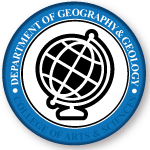GREENLAND REVISITED: LAKE EFFECTS ON COASTAL NUTRIENT FLUXES
Author ORCID Identifier
Deuerling - https://orcid.org/0000-0001-8825-0546
Document Type
Presentation
Publication Date
10-12-2021
Abstract
Retreat of continental ice sheets exposed ~15% of Earth’s land surface from the Last Glacial Maximum (LGM) to about 6 ka and recent warming has increased glacial melting and meltwater solute fluxes to the oceans. Additional solutes originate from non-glacial streams in landscapes exposed since the LGM. As presented in last year’s pandemic-modified Birdsall-Dreiss lecture, Greenlandic glacial and non-glacial streams have distinct solute concentrations because of differing chemical weathering regimes of comminuted glacial sediment. In this year’s lecture, we evaluate an ~46 km2 non-glacial watershed near Sisimiut, Greenland to assess how lakes may impact non-glacial solute fluxes. Snow accumulates in the watershed from October to freshet in early May, after which discharge responds solely to precipitation events. Three main tributaries provide 92% of flow to the outlet stream and drain sub-watersheds with median slope angles of 16 to 18% and small upland lakes that cover 0.5 and 3.8% of the land area. In contrast, the outlet stream discharges from a landscape with a median slope of ~6% that includes one large and one small lake covering 23% of the area. Streams above and below the outlet lakes show similar variations in solute concentrations through the melt season. However, soon after freshet the outlet stream has major element concentrations ~20% greater than in the tributaries. The excess solute concentrations decrease linearly for ~90 days at which time the tributaries and outlet have similar concentrations. The excess solutes at the outlet may result from over-winter mineral dissolution in lake sediments, cryogenic solute enrichment during lake freeze-in, or dilute runoff in tributaries from snowmelt during and soon after freshet. In contrast, the outlet stream has a 0.6 to 3 times deficit of PO4, NO3, and Si compared with the tributaries, suggesting assimilation within the lake. NH4 concentrations switch from ~60% deficit to ~ 60% excess, reflecting a switch from a lake sink to source. The differences between tributary and outlet stream compositions suggest lake development may have altered coastal nutrient fluxes from non-glacial streams post-LGM. These variations will modify differences in glacial and non-glacial nutrient fluxes to coastal ecosystems, both since the LGM and as melting increases in a future warmer world.
Recommended Citation
Martin, Jonathan; Pain, Andrea; Martin, Ellen; Black, Megan; and Deuerling, Kelly M., "GREENLAND REVISITED: LAKE EFFECTS ON COASTAL NUTRIENT FLUXES" (2021). Geography and Geology Faculty Proceedings & Presentations. 12.
https://digitalcommons.unomaha.edu/geoggeolfacproc/12


Comments
This is a oral presentation at the GSA Connects 2021 in Portland, Oregon Session No. 198.
This was deposited with permission from the publisher. For more information visit https://doi.org/10.1130/abs/2021AM-366727
© Copyright 2021 The Geological Society of America (GSA), all rights reserved. Permission is hereby granted to the author(s) of this abstract to reproduce and distribute it freely, for noncommercial purposes. Permission is hereby granted to any individual scientist to download a single copy of this electronic file and reproduce up to 20 paper copies for noncommercial purposes advancing science and education, including classroom use, providing all reproductions include the complete content shown here, including the author information. All other forms of reproduction and/or transmittal are prohibited without written permission from GSA Copyright Permissions.
Geological Society of America Abstracts with Programs. Vol 53, No. 6 doi: 10.1130/abs/2021AM-366727